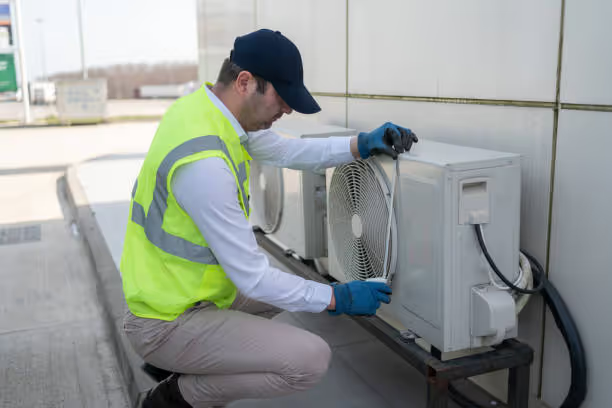Heat Pump Repair Thonotosassa, FL

When your heat pump falters in Thonotosassa, timely heat pump repair is essential for restoring home comfort and efficiency. This page covers key signs of problems, such as inconsistent temperatures or unusual noises. Our meticulous repair process includes comprehensive diagnostics, precise problem identification, expert repair, and thorough testing. We also help Thonotosassa homeowners determine if repairing their unit or investing in a new heat pump is the best long-term solution for optimal performance and reliability.

Expert Heat Pump Repair in Thonotosassa
When your heat pump falters, the comfort of your Thonotosassa home is immediately compromised. Whether you're facing the sweltering heat of summer or a surprising winter chill, a malfunctioning heat pump is an urgent problem. These versatile systems work year-round to provide both heating and cooling, making their proper function essential for Florida living. A timely, professional repair not only restores your immediate comfort but also protects your system’s efficiency and longevity. Our dedicated technicians possess specialized knowledge of heat pump systems, ensuring a precise diagnosis and effective repair for residents throughout the Thonotosassa area.
Signs Your Heat Pump Needs Professional Attention
It’s not always obvious when a heat pump is on the verge of a breakdown. Recognizing the early warning signs can help you address issues before they escalate into more severe and costly problems. If you notice any of the following symptoms, it is time to consider a professional inspection.
Inconsistent or Inadequate Temperature Control
One of the most common indicators of a problem is when your system fails to perform its primary function. If your heat pump is blowing lukewarm or cool air when it’s set to heat, or warm air when it’s in cooling mode, there could be an issue with the reversing valve, refrigerant levels, or the compressor.
Unusual and Disruptive Noises
Your heat pump should operate with a relatively low level of sound. Sudden or loud noises are a clear signal that something is wrong.
- Grinding or Squealing: These sounds often point to worn-out motor bearings or other moving parts that require immediate service to prevent further damage.
- Gurgling or Bubbling: This can indicate a low refrigerant charge or a leak in the refrigerant line, which significantly impacts performance.
- Loud Clicking or Clanking: While some clicking is normal during startup and shutdown, persistent or loud clanking can suggest a problem with the fan blades hitting an obstruction or a failing component within the compressor.
Constant Operation or Short Cycling
A heat pump that runs continuously or turns on and off in rapid succession (short cycling) is struggling to reach the set temperature. This is not only a sign of a potential issue, such as a clogged filter, a thermostat malfunction, or incorrect refrigerant levels, but it also drives up your energy consumption and puts excessive strain on the system.
A Sudden Spike in Energy Bills
If your utility bills have increased unexpectedly without a corresponding change in your usage habits, your heat pump’s efficiency may be compromised. A struggling system has to work harder and longer to heat or cool your home, leading directly to higher energy costs.
Ice or Frost on the Outdoor Unit
While a thin layer of frost can be normal during the winter and should be handled by the unit's defrost cycle, a heavy buildup of ice on the outdoor coils is problematic. This can be caused by a dirty filter restricting airflow, low refrigerant, or a malfunctioning defrost control board, all of which hinder the unit's ability to transfer heat effectively.
Our Meticulous Heat Pump Repair Process
A successful repair begins with an accurate diagnosis. Our approach is thorough and systematic, designed to identify the root cause of the problem and provide a lasting solution.
Step 1: Comprehensive System Diagnostics
A technician will perform a detailed inspection of your entire heat pump system. This involves checking thermostat calibration, inspecting air filters for blockages, examining indoor and outdoor coils, and verifying proper airflow. Electrical connections are tightened and tested, and safety controls are verified for correct operation.
Step 2: Precise Problem Identification
Using advanced diagnostic tools, the technician will measure refrigerant pressure to check for leaks or improper charging, test the compressor and fan motors for electrical integrity, and inspect the reversing valve—the critical component that switches the unit between heating and cooling modes. This detailed analysis ensures the exact source of the malfunction is found.
Step 3: Clear Explanation and Repair Execution
Once the problem is identified, the technician will explain the findings in clear, understandable terms. With your approval, the repair will be carried out using high-quality components and industry-best practices. Whether it involves recharging the refrigerant, replacing a faulty capacitor, repairing a motor, or fixing a complex electrical issue, the work is performed with precision and care.
Step 4: Final System Testing and Optimization
After the repair is complete, the job isn’t finished. The technician will cycle the system through both heating and cooling modes to confirm that it is operating at peak performance. Air temperature output is measured, and system pressures are re-checked to ensure everything is functioning according to manufacturer specifications, guaranteeing your comfort and the system’s efficiency.
Deciding Between Repair and Replacement
A common question for Thonotosassa homeowners is whether to repair a failing heat pump or invest in a new one. Several factors influence this decision. If your unit is relatively new (less than 10 years old) and has been well-maintained, a repair is often the most cost-effective choice, especially for minor issues. However, if your heat pump is older, requires frequent and increasingly expensive repairs, or relies on outdated R-22 refrigerant, replacement may be a wiser long-term investment. A new, high-efficiency system can provide significant energy savings and improved reliability, offsetting the initial cost over time. Our technicians can provide a transparent assessment to help you make an informed decision based on your system’s condition and your budget.










